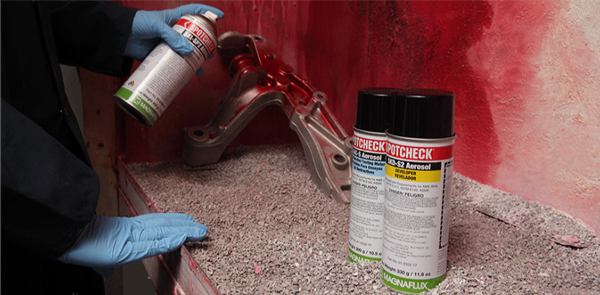着色渗透检测也称为液体渗透检测,用来检测开口于表面的缺陷。其原理是利用毛细作用来完成渗透检测。
液体渗透检测的步骤如下:
- 表面准备去除表面油污等干扰渗透剂进入表面缺陷的杂质。
- 施加渗透剂,通常使用红色的着色渗透,温度范围在5度 到 52度之间。
- 渗透驻留过程,渗透过程时间在5-60分钟,渗透过程是通过毛细作用完成。
- 去除表面多余的渗透剂,去除多余渗透剂过程时候要避免过清洗,以及清洗不足。
- 施加显像剂 ,显像剂应该薄而均匀的施加在待检表面。
- 检验应在施加显像剂10-60分钟后进行,至少光照强度在1000Lux.

Dye Penetrant Test (DPT) is also known as Liquid Penetrant Inspection (LPI) or Penetrant Test (PT). It is one of the most widely used Non Destructive Test (NDT) methods. It can be used to inspect almost all non-porous materials such as metals, plastics, ceramics etc. We can detect any opened surface discontinuity (or flaw) such as surface cracks, porosity, pinholes etc. by this test method.
Principle: DPT is based upon a natural phenomenon called as CAPILLARY ACTION. By the virtue of capillary action, a liquid tends to flow or seep in narrow spaces (or openings) even against the external forces like gravity. This phenomenon occurs due to the molecular attraction.
STEPS TO BE FOLLOWED FOR DYE PENETRANT TEST:
Procedure for Dye Penetrant Test can vary depending upon the factors such as the penetrant system being used and the condition and environment under which the inspection is performed. However, the general steps which are to be followed are as below:
1. Surface Preparation: The surface must be thoroughly cleaned, to make it free from dirt, oil, paint, grease, water, or other contaminants. For cleaning one can use dry cloth, solvents, cleaner, rust remover etc. depending on the condition of the surface to be inspected.
2. Penetrant Application: After thorough cleaning, Penetrant is applied. Penetrant is a red colored Liquid. It can be applied on the surface by spraying (most common) or by brushing or by immersing the entire surface in a penetrant bath. Temperature of the surface shall be between 5C to 52C.
3. Dwell period: Leave the penetrant, as it is, on the surface for a minimum period of time (Known as Dwell Time or Dwell Period). During dwell period, penetrant seeps into the flaws (if present on the surface being inspected), due to Capillary action. Dwell period varies from 5 minutes to 60 minutes or even more than that depending upon the material and its service condition. Penetrant manufacturer also mentions the dwell period on the product itself. However, there is no harm in going beyond the minimum dwell period, provided that the temperature shall be ambient, because at elevated temperature chances of penetrant getting evaporated will be always there. Hence at elevated temperature, one should strictly restrict to the recommended dwell time.
4. Removal of excess penetrant: After leaving the surface for recommended dwell period, the penetrant shall be cleaned, for cleaning the excess penetrant cloth and penetrant removal shall be used.
5. Application of Developer: After thorough cleaning, a thin layer of developer is applied. Two things shall be taken care of while spraying the developer.
6. Inspection: After application of developer wait for 10 to 60 minutes and then perform the inspection. Appropriate lighting is necessary to detect the indications from any flaws which may be present. Minimum light required is 1000 Lux or 100 foot candles.

 鲁公网安备 37020602000203号
鲁公网安备 37020602000203号